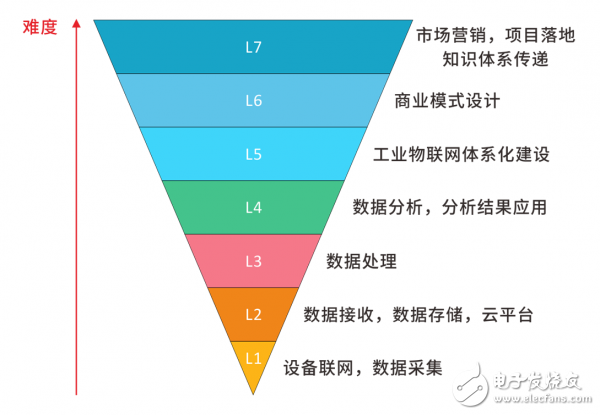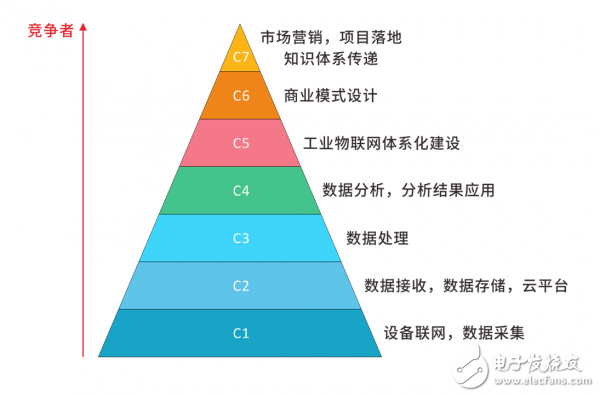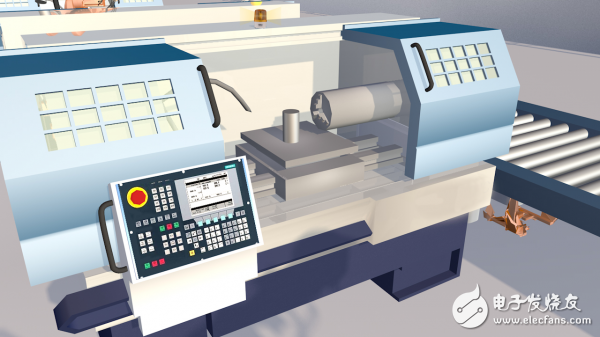In recent years, the development of the Industrial Internet of Things has been in full swing, and various service providers and integrators have sprung up continuously to compete in the market. However, the deployment and landing of the Industrial Internet of Things in industrial manufacturing is not optimistic. Then, what is the difficulty of developing the Industrial Internet of Things? In other words, which capabilities are the core competitiveness of industrial IoT manufacturers?

We summarize the difficulty of the Industrial Internet of Things as an inverted triangle.

The technical difficulty of the Industrial Internet of Things
However, in the actual market, the competitive state of the Industrial Internet of Things presents a positive triangle.

Distribution of Competitors in the Industrial Internet of Things Market
Why is there such a distribution? Let's start with the technical system of the Industrial Internet of Things.
We divide the technical application of the Industrial Internet of Things into the following seven layers:
Level L1, C1: Equipment networking, data collectionWith the rapid development of the Industrial Internet of Things, many traditional industrial manufacturing companies have turned their attention to device data. To achieve smart management and data processing, the first step is to obtain device data. So is data collection difficult for industrial equipment? Can't equipment manufacturers do it themselves? of course not.
In fact, industrial equipment data collection is to be a hardware terminal to interact with the equipment. As long as you understand the physical interface, interaction protocol, data type, etc. of the interaction, this matter is not difficult. However, why equipment manufacturers with agreements do not collect data by themselves, but obtain data through a third party. The difficulty lies not in the data collection itself, because the data of industrial equipment is massive and disorderly.
For example, a single CNC machine tool can generate 400M data per second. It is calculated based on a production line with 10 stations and 10 equipment. If there are five production lines, a simple factory can produce data per second. It reaches 20G, and the traffic of ordinary mobile phones we use is only about 10G per month.

In addition to data collection, data storage, classification, processing, etc. are also problems that manufacturers need to face and solve. The current situation of China's manufacturing industry determines that data collection will be a very large market demand, which is giving birth to a large number of hardware manufacturers, data collection integrators and other service companies that provide basic data interoperability capabilities.
Level L2, C2: data reception, data storage, cloud platformIs the cloud platform difficult? Equipment manufacturers can’t do it themselves, can’t other software companies do it? Is MQTT the Internet of Things?
Of course it is negative.
The difficulty of the cloud platform is of course more difficult than that of a data collection terminal, but in the final analysis, the cloud platform is still a solution to the large-scale access processing capabilities of the terminal. How to solve the problem of large-scale concurrent data storage is also a pure technical problem. Equipment manufacturers can’t do it, and there are still many IoT companies that can do it, such as Alibaba Cloud, Huawei Cloud, and Inovance. What they fancy is their cloud deployment capabilities and strong strength. They have a relatively high guarantee for the data deployed in the cloud. This is what ordinary enterprises want to do but cannot do well.
But having said that, industrial Internet of Things data is a time series data. In most cases, the relational database that software companies are usually familiar with cannot be used. This is a big threshold for Internet of Things companies, but the threshold is not indispensable. Overstep.
Level L3, C3: Data processingAlthough the cloud platform solves the needs of data reception and storage, everyone in the industry knows that this is a very complex time-series data storage. What should I do after the data is saved to the cloud platform? This matter is simple in mind, but the actual deployment is somewhat difficult.
In recent years, a large number of Internet of Things cloud platform service providers have emerged in the market, but most of them have gaps in capabilities and do not have complete data processing capabilities. The collected data is like a pile of flour, and non-professional cloud platforms also Just like a flour warehouse, a pile of flour is placed in the warehouse. During this period, only the pile of flour keeps increasing. Massive and scattered data will not bring value to the enterprise.
The so-called data processing is to carry out a high degree of abstraction of the data, and carry out the necessary processing, so that the data can be stored in a more orderly manner, and efficiently retrieved, which is convenient for subsequent data application, statistics, analysis and calculation.
In fact, this link of data processing is easy to be ignored. The vast majority of IoT service providers don’t understand how data processing works, let alone how to do a good job of data processing. They can only directly transfer the data collected during the storage process. Application, which brings a series of problems:
Faced with a large amount of data, only scattered data can be displayed, but data association relationships cannot be accurately judged, and decision-making cannot be assisted. At this level, the strength gap of various Internet of Things companies has been clearly manifested. Companies that can effectively process data can often enter the industry more quickly and provide customers with data value.
Level L4, C4: data analysis, application of analysis resultsThe Internet of Things platform is beginning to become civilians, and non-IT professionals can easily use handicraft APP applications, which is not difficult for most companies.
The dilemma of the Industrial Internet of Things is that it has to face a bunch of data, but it is impossible to see effective information from the data, which is even more difficult for data applications. The purpose of data analysis is to figure out the meaning behind these industrial data. The difficulty of this thing far exceeds the previous three things. Even software companies may not have this ability, because programmers cannot do these things, and mathematical engineers may not be able to do them. To realize the analysis and application of data, it is necessary to bridge the gap between mathematics and engineering and build a bridge between mathematics and engineering.
Data analysis has two aspects for the Industrial Internet of Things:
ï¼Aï¼ Analyze data and form analysis results, which is a basic thing that data analysis must do.
ï¼Bï¼ Reasonable application of analysis results.
At this stage, industrial Internet of Things companies are generally still in the first "analysis of data", and very few start to do the second.
Analysis is a means, not an end. The purpose of analysis is to apply the results of the analysis. For IIoT, the purpose of analysis is to achieve safe production + energy saving + emission reduction + efficiency improvement. This matter is a real thing, and it is difficult for companies that just tout the concept and cannot really implement predictive maintenance. Smart IoT has realized a comprehensive enabling platform for device connection, data processing, and business applications. It can be applied to various industrial scenarios and process various devices and data. The current amount of industrial equipment access reaches 200,000 units, which has accumulated more than 200,000 units. 10T industrial operating data.
Level L5, C5: Systematic construction of industrial Internet of ThingsThe systematic construction of the Industrial Internet of Things is the most proud place for industrial Internet of Things solution providers. To a certain extent, it is also different from other Internet of Things companies and is the real soft power of enterprises in market competition.
In the torrent of the Internet of Things, there may be many people or companies doing data collection, cloud platforms, data processing, and data analysis, but few truly form a complete system. Cisco is an industry model. When they developed the first network router, this router was already a member of the Cisco system. Their system included product series, product lines, Cisco standards, Cisco Unified Scripting Language, etc. .
If this matter is not done right at the beginning, the subsequent system will basically be unable to be constructed and perfected.
Level L6, C6: Business modelThe business model of the Industrial Internet of Things is very different from the Internet model. If you don't pay attention, you will get into trouble.
For example, IIoT has targeted equipment manufacturers a long time ago. We think this is the best way to directly open the door of device data.
The general industrial IoT demand of equipment manufacturers is to let manufacturers know who their customers are, as well as equipment location, equipment operation method, equipment operation mode, fault problem, troubleshooting, and understand the use of the same equipment in different places. Differences, different user habits have different effects on the operation of the equipment, etc. There is no doubt that through the Internet of Things, let them change the service from passive to active.
Smart Things will spare no effort to provide manufacturers with the required program services. The core of the smart IoT model is that while providing services to equipment manufacturers, it also provides a series of applications based on EXP (Expert), including edge computing terminals, which provide equipment users with tools and sharp weapons to allow equipment to use People get benefits, they can better understand the operation of the equipment, understand the potential risks of the equipment, and know how to adjust the operating parameters to achieve the effect of energy saving and productivity increase. Manufacturers can treat applications as additional value-added services to their customers. These value-added services have the possibility of profitability and provide the possibility to digest the new costs brought by the Internet of Things.
Different companies will make detours more or less when they start, but they will eventually go out of their own business models. The choice of business model determines how the company will grow and occupy in the market over a period of time. s position. There is no right or wrong model, but the market will make an appropriate choice.
Level L7, C7: Marketing, project implementation, knowledge system transferThis is the ultimate link and the "last mile" of value realization.
Regardless of whether it is a policy promotion or a market red sea, the marketing of the Industrial Internet of Things has gradually matured, and a large number of domestic implementation projects have been implemented. From the demonstration project of the Industry and Information Commission to the "platform on the cloud" in Guangdong Province, it shows a thriving The prosperous scene.
Smart Internet of Things is an enterprise with a complete industrial Internet of Things system. It has accumulated a lot of experience in many industries. Our knowledge system is continuously recognized in the industry and has the value of delivery. From the most simple level, let customers learn how to use the MIXIOT platform, such as how to determine the object of the Internet of Things, how to write the complex correspondence between the data collection terminal (adapter) and the device, how to compile a unified code, and how to lay out the data display panel , How to run related statistical reports, how to configure analysis items, how to understand the analysis results, how to tell the device the output strategy of the edge computing terminal, etc.
Going deeper is to let customers learn how to use the MIXIOT platform to solve more complex problems, from a single device to a device composed of multiple devices, to a production line composed of multiple devices, a workshop composed of multiple production lines, to the entire factory... . , The deeper meaning is that MIXIOT has become a standard for problem-solving, and the creator of this standard is Wisdom of Things.
Often, we not only tell customers what kind of industrial IoT you need, but also provide effective tools and standard methods. It must be clearly understood that manufacturers should not only focus on providing various hardware, software, platforms, and data models, but should provide users with these hardware, software, platforms, and data models, and ways to serve themselves.
10 inch tablet is the most important size on tablet market. Which kind of clients like more? The answer is loving bigger size or storage, longer working time, etc. Since Android Tablet 10 inch is usually equipped with full HD screen, memory support up to 8GB, storage up to 256GB, battery up to 7000mAh-working 5-8hours. However, 8 inch android tablet mainly up to 4GB ram 64GB ROM, 4000mAh battery. At this store, you can see more than ten different 10 inch tablets on sale and one 10 inch windows tablet with magnetic keyboard option, and high level CPU and SIM Card option. Besides, you can also see amazon tablet 10 inch with competitive cost, especially take above 1000pcs. Except android tablet, 14 inch 64Gb Student Laptop for online learning, 15.6 inch celeron n5095 business laptop, 15 inch intel i3, i5, i7 10th or 11th generation Gaming Laptop and 16 inch laptop with 4gb graphics card and 16gb ram 512GB ssd alternatives also.
Any other special requirements, just fee free to contact us. Will try our best to support you.
10 Inch Tablet,10 Inch Tablets On Sale,Android Tablet 10 Inch,Amazon Tablet 10 Inch,10 Inch Windows Tablet
Henan Shuyi Electronics Co., Ltd. , https://www.shuyitablet.com